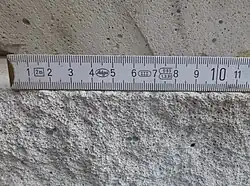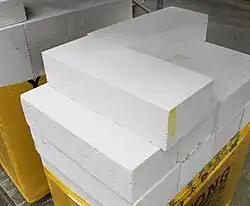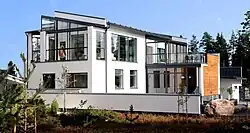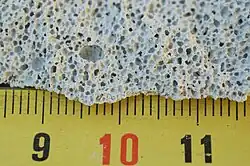Autoclaved aerated concrete


Autoclaved Aerated Concrete (AAC), also known as autoclaved cellular concrete or autoclaved concrete, is a lightweight, prefabricated concrete building material. AAC, developed in the mid-1920s by Dr. Johan Axel Eriksson, is used as an alternative to traditional concrete blocks and clay bricks.[1] Unlike cellular concrete, which is mixed and poured on-site, AAC products are prefabricated in a factory.[2]
The composition of AAC includes a mixture of quartz sand, gypsum, lime, Portland cement, water, fly ash, and aluminum powder.[3] Following partial curing in a mold, the AAC mixture undergoes additional curing under heat and pressure in an autoclave.[4] AAC is used in a variety of forms, including blocks, wall panels, floor and roof panels, cladding panels, and lintels.[5]
Cutting AAC typically requires standard power tools fitted with carbon steel cutters.[6][7] When used externally, AAC products often require a protective finish to shield them against weathering. A polymer-modified stucco or plaster compound is often used for this purpose, as well as a layer of siding materials such as natural or manufactured stone, veneer brick, metal, or vinyl siding.[8]
History

AAC was first created in the mid-1920s by the Swedish architect and inventor Dr. Johan Axel Eriksson (1888–1961),[9][10] along with Professor Henrik Kreüger at the Royal Institute of Technology.[9][10] The process was patented in 1924.[11] In 1929, production started in Sweden in the city of Yxhult as "Yxhults Ånghärdade Gasbetong", which later became the world's first registered brand of building materials: Ytong.[12] Another brand, "Siporex", was established in Sweden in 1939. This was followed by the establishment of another cellular concrete brand, Hebel, which opened their first plant in Memmingen, Germany, in 1943.[13] Following a mid-20th century boom, demand declined in Western Europe, and no new plants were constructed after the 1990s.[14]
Ytong AAC was originally produced in Sweden using alum shale, which contained combustible carbon beneficial to the production process. However, these deposits were found to contain natural uranium, which presented a hazard as it decayed over time and accumulated as radon gas. This problem was brought up in 1972 by the Swedish Radiation Safety Authority, and by 1975, Ytong abandoned alum shale in favor of a combination of quartz sand, calcined gypsum, lime (mineral), cement, water, and aluminium powder.[13]
In 1978, Siporex Sweden opened a Siporex Factory in Saudi Arabia, establishing the Lightweight Construction Company (LCC), supplying Gulf Cooperation Council countries with aerated blocks and panels. Since 1980, there has been a worldwide increase in the use of AAC materials.[15][16] New production plants are being built in Australia, Bahrain, China, Eastern Europe, India, and the United States. The use of AAC has expanded globally, particularly in regions experiencing rapid urban development.[17]
AAC Blocks were introduced in India in the early 1990s. One of the first manufacturers in the country was Biltech Building Elements Limited, which began AAC production in 1993 at its Palwal, Haryana facility.[18][19][20] In 2017, Biltech acquired the AAC manufacturing units of Siporex India, becoming the exclusive manufacturer and owner of the Siporex brand in the country.
Today, the manufacturing of autoclaved aerated concrete (AAC) is centered in Europe and Asia, with some limited production facilities in the Americas, and one known plant in Egypt.[21] While growth in the European market has slowed, AAC production in parts of Asia has expanded, particularly in response to urban development demands. As of 2025, China remains the world's largest autoclaved aerated concrete market, hosting over 2,000 manufacturing plants and producing approximately 190 million cubic meters of AAC annually.[22][23]

Uses
AAC is used for both exterior and interior construction.[25] It is used in high-rise construction projects and areas with frequent temperature fluctuation.[26] Due to its lower density, AAC can reduce a building's structural load, potentially decreasing the required amounts of steel reinforcement and conventional concrete in certain building applications. Necessary quantities of mortar are also reduced due to the decreased number of joints in AAC builds. Similarly, less material is required for rendering because AAC can be shaped with precision before installation. Although regular cement mortar is compatible with AAC, many buildings employing its components utilize thin bed mortar, typically around 3.2 millimetres (1⁄8 in) thick, in accordance with specific national building codes.
Manufacturing
The aggregate used in AAC typically consists of finely ground sand or fly ash, depending on regional availability.[27] Binding agents include quartz sand, lime, calcined gypsum, cement, and water. Aluminium powder constitutes 0.05–0.08% by volume. Some countries (such as India and China) use fly ash from coal-fired power plants (50–65% silica) as the aggregate.[28]
When AAC is mixed and cast, aluminium powder reacts with calcium hydroxide and water to form hydrogen. The hydrogen gas is dispersed through the AAC mix, creating a foam, doubling the volume of the raw mix. This process can create gas bubbles up to 3 millimetres (1⁄8 in) in diameter.[29] At the end of the foaming process, the hydrogen escapes into the atmosphere and is replaced by air, resulting in a product weighing approximately 20% of the weight of conventional concrete.
Upon removal of the mold in which the AAC is cast, the material is solidifed but remains soft. It is then cut into the desired shape (either blocks or panels), and placed in an autoclave chamber for 12 hours. During this steam pressure hardening process, temperatures reach 190 °C (374 °F) and the pressure reaches 800 to 1,200 kPa (8.0 to 12.0 bar; 120 to 170 psi). At these conditions, quartz sand reacts with calcium hydroxide to form calcium silicate hydrate, which gives AAC its high strength and other unique properties. Because of the relatively low temperature used, AAC blocks are not considered to be a type of fired brick but rather a lightweight concrete masonry unit. After the autoclaving process, the material is stored and shipped to construction sites for use. Depending on its density, up to 80% of the volume of an AAC block is air. AAC's low density also accounts for its low structural compression strength. It can carry loads of up to 8,000 kPa (1,200 psi); approximately 50% of the compressive strength of regular concrete.
Reinforced autoclaved aerated concrete
Reinforced autoclaved aerated concrete (RAAC) is a reinforced version of autoclaved aerated concrete, commonly used in roofing and wall construction. The first structural reinforced roof and floor panels were manufactured in Sweden and production of the first autoclaved aerated concrete blocks began there in 1929. However, following the Second World War, Belgian and German technologies became market leaders for RAAC elements.
In Europe, RAAC gained popularity in the mid-1950s as a cheaper and more lightweight alternative to conventional reinforced concrete, with documented widespread use in a number of European countries, as well as Japan, and former territories of the British Empire.[30][31]
RAAC was used in roof, floor, and wall construction due to its lighter weight and lower cost compared to traditional concrete.[32] Additionally, RAAC was also used due to its fire resistance properties. The material does not require plastering to achieve fire resistance and fire does not cause spalls.[33] RAAC elements have also been used in Japan as walling units, due to their properties under seismic movement.
However, RAAC has also been shown to have limited structural reinforcement bar (rebar) integrity in 40 to 50 year-old roof panels. This was first observed in the 1990s, where the material was susceptible to failure without any visible signs of deterioration.[34][35][36][37][38] This is often caused by RAAC's high susceptibility to water infiltration due to its porous nature, which causes corrosion of internal reinforcements in ways that are hard to detect externally. This places increased tensile stress on the bond between the reinforcement and concrete, lowering the material's service life. Detailed risk analyses are required on a structure-by-structure basis to identify areas in need of maintenance and lower the chance of catastrophic failure.[39]
Public concerns around these weaknesses were first raised by engineers in the United Kingdom in 1995, following inspections of cracked units in British school roofs.[40] Action was subsequently taken in 2022 when the Government Property Agency declared the material to be life-expired,[41] and in 2023 when multiple buildings were found to have issues with their RAAC construction.[42][43][44] This resulted in the partial or total closure of 174 schools at risk of a roofing collapse.[45][46] These incidents caused an increase in apprehension among the public, as members of the public discovered that their buildings had been made using RAAC.[47][48][49] This also raised alarm around the development of similar problems in other countries as RAAC saw widespread use.[31]
On June 21, 2024, the Ontario Science Centre, a major museum in Toronto, Canada, permanently closed its original site due to the severely deteriorated roof panels dating back from its opening in 1969. Despite the proposed repair options, the provincial government of Ontario, who retained ownership over the center, had already announced plans to relocate the center, and therefore requested immediate closure of the facility instead of funding repairs. Approximately 400 other public buildings in Ontario are understood to contain the material and are under review, but no other closures were anticipated at the time of the Science Centre closure.[50]
Sustainability
The high resource efficiency of autoclaved aerated concrete allows AAC to have a lower environmental impact than conventional concrete, from raw material processing to the disposal of aerated concrete waste. Thanks to continuous improvements in efficiency, the production of aerated concrete blocks requires relatively little raw materials per cubic meter of product and material cost can be up to five times lower than the production of other building materials.[51] There is little loss of raw materials in the production process, and all production waste is returned to the production cycle. Production of aerated concrete requires less energy than for all other masonry products, thereby reducing the use of fossil fuels and associated carbon dioxide (CO2) emissions.[52] The curing process also saves energy. Steam curing occurs at relatively low temperatures, and the hot steam generated in the autoclaves is reused for subsequent batches.[53][54]
Advantages

Autoclaved aerated concrete (AAC) has been used in construction since the early 20th century and is valued for its lightweight and insulating properties.
AAC possesses several characteristics that make it suitable for specific construction applications:
- Thermal efficiency: Due to its cellular structure, AAC offers thermal resistance that may help reduce heating and cooling loads in buildings. [55]
- Fire resistance: AAC exhibits good fire resistance; its mineral composition and porous structure can provide extended fire ratings under standard testing conditions. [56]
- Workability: AAC can be cut and shaped using standard tools, allowing for precise fitting and reducing material waste on construction sites.
- Environmental profile: AAC generally has a lower embodied energy and environmental footprint compared to traditional concrete. In some contexts, it may contribute to achieving points in green building certification systems such as LEED.[57]
- Low density: The material is significantly lighter than conventional concrete, which can simplify manual handling, reduce transportation demands, and may lower structural loads in seismic design scenarios.[58]
- Construction efficiency: AAC blocks and panels are often available in larger dimensions than traditional masonry units, potentially reducing installation time and labor. However, the overall impact on construction schedules depends on site-specific logistics and integration with other systems. [59]
- Moisture regulation: The vapor-permeable nature of AAC allows for limited water vapor diffusion, which can help moderate indoor humidity and mitigate moisture accumulation or condensation-related issues. [60]
- Dimensional accuracy: Factory production techniques yield blocks and panels with tight tolerances, which can reduce the need for on-site trimming and minimize the use of finishing materials such as mortar or plaster.
- Durability: AAC is resistant to pests, mold, and typical climate variations. It maintains its structural and thermal performance over time under normal conditions, although its long-term durability may depend on design detailing and exposure environments. [61]
Disadvantages
Autoclaved aerated concrete (AAC) also presents several limitations, particularly in regions with construction practices that differ from monolithic masonry, such as the United Kingdom, where cavity wall systems are common.
- Specialized training: Installation of AAC requires construction techniques that may differ from those used with traditional masonry. As a result, builders may need targeted training to handle, cut, and assemble AAC components effectively[62]
- Shrinkage cracks: Non-structural shrinkage cracks may develop in AAC installations, particularly under humid conditions or after rainfall. This phenomenon is more frequently observed in low-quality blocks or those that have not undergone adequate steam-curing during production.[63]
- Brittleness: AAC is more brittle than conventional clay bricks or dense concrete blocks. This characteristic necessitates careful handling during transport and installation to minimize breakage.
- Fixings and fasteners: Due to its porous and brittle composition, AAC requires specialized fasteners for securing fixtures such as cabinets or shelves. Long screws and wall anchors designed for AAC, gypsum board, or lightweight masonry are typically used. Conventional plastic wall plugs and masonry drill bits are generally unsuitable. [64] In high-load applications, certified anchors may be required,[65][66][67] and drilling should be performed using high-speed steel (HSS) drill bits without hammer action to avoid cracking.[65][66]
- Insulation limitations: AAC blocks manufactured at lower densities (e.g., 400 kg/m³ under European Standard B2.5) may require substantial wall thicknesses—often exceeding 500 mm—to meet thermal insulation standards in colder climates such as Northern Europe. This can offset space and cost benefits in some applications.[62]
- Water sensitivity: The aerated structure of AAC contains fine air voids, which can absorb moisture. In freeze–thaw environments, absorbed water may expand upon freezing and cause damage to the block structure. Protective finishes and proper detailing are typically recommended in such conditions.[68]
- Logistics: Due to the lower density, the same amount of concrete uses up more storage space. While traditional concrete can be mixed directly on site or off site it doesn’t require any intermediate storage, while large shipments of AAC bricks often take up a lot of valuable space on construction sites or in storage. Storing sacks of cement or silos of cement uses up less space per final volume, since sand and gravel are usually stored outside or off site.
References
- ^ "Climate Action Network International Briefing, Copenhagen March Ministerial March 2023". Climate Change and Law Collection. doi:10.1163/9789004322714_cclc_2023-0001-0004. Retrieved 1 January 2025.
- ^ "Advantages of Using AAC Blocks | Blocktec". Blocktec AAC Wall System. Retrieved 9 April 2025.
- ^ "Autoclaved Aerated Concrete". Mumbai: Bennett & Coleman Ltd. Retrieved 12 July 2023.
- ^ "Autoclaved aerated concrete (AAC)". Victoria: Connection Magazines. Retrieved 11 July 2023.
- ^ "Products specifications - AIRCRETE". aircrete-europe.com. Archived from the original on 2 April 2015. Retrieved 16 July 2014.
- ^ "AAC can bring down construction cost by up to 20 percent". Indian Cement Review. 31 October 2015.
- ^ "Using Autoclaved Aerated Concrete Correctly". Masonry Magazine. 1 June 2008. Retrieved 28 November 2018.
- ^ "Autoclaved Aerated Concrete". Washington: Portland Cement Association. Retrieved 12 July 2023.
- ^ a b "Hebel: The History of AAC". Archived from the original on 4 November 2010.
- ^ a b Berg, Samuel A (2004). "Pionjärinsatser i betongens barndom - Konstruktionsbetongens historia 1890-1950" [Swedish Association of Historical Buildings: Pioneering work in the early days of concrete - history 1890–1950]. Byggnadskultur (in Swedish) (4/2004). Archived from the original on 25 May 2012. Retrieved 9 February 2021.
- ^ "History of AAC". European Autoclaved Aerated Concrete Association. Retrieved 18 June 2025.
- ^ "BIM objects - Free download! Ytong | BIMobject". BIMobject. Retrieved 27 December 2024.
- ^ a b "Autoclaved Aerated Concrete (AAC)". Material Testing Expert. Retrieved 27 December 2024.
- ^ "History of Autoclaved Aerated Concrete - Aircrete Europe". www.aircrete.com. 26 September 2018. Retrieved 10 January 2025.
- ^ Minerals Yearbook. The Bureau. 1998. p. 120.
- ^ "Autoclaved aerated concrete in vietnam" (in Vietnamese). Retrieved 11 August 2024.
- ^ Gyurkó, Zoltán; Jankus, Bence; Fenyvesi, Olivér; Nemes, Rita (1 September 2019). "Sustainable applications for utilization the construction waste of aerated concrete". Journal of Cleaner Production. 230: 430–444. Bibcode:2019JCPro.230..430G. doi:10.1016/j.jclepro.2019.04.357. ISSN 0959-6526.
- ^ "Press Trust Of India". www.ptinews.com. Retrieved 15 July 2025.
- ^ "| News On Project". www.newsonprojects.com. Retrieved 15 July 2025.
- ^ "Biltech India | Sustainable AAC Block And Panels Manufacturers". 11 June 2024. Retrieved 15 July 2025.
- ^ Group, Plena. "Delta Block – Plena Group". Retrieved 20 August 2025.
{{cite web}}:|last=has generic name (help) - ^ "Turnkey services for autoclaved aerated concrete projects". Retrieved 13 May 2025.
- ^ "AAC China digital". Retrieved 13 May 2025.
- ^ "Jämerä Sämsö Seinäjoki 2016" (in Finnish). Espoo: Jämerä Kivitalot Oy. 2016. Retrieved 26 July 2023.
- ^ Hornbostel, Caleb (16 January 1991). Construction Materials: Types, Uses and Applications. John Wiley & Sons. p. 959. ISBN 978-0-471-85145-5.
- ^ Gangurde, Abhimanyu Savliram (16 November 2019). AAC block manufacturing and its application in building construction.: Complete solution for AAC block manufacturing and use in building construction. Abhimanyu Savliram Gangurde. p. 8.
- ^ Gangurde, Abhimanyu Savliram (16 November 2019). AAC block manufacturing and its application in building construction.: Complete solution for AAC block manufacturing and use in building construction. Abhimanyu Savliram Gangurde. p. 12.
- ^ Muñoz-Pérez, Sócrates Pedro; Lozano-Sánchez, Jaime Jamill; Ramírez-Silva, Diana Mareline; Vallejos-Madianero, Joicie Elizabeth (9 October 2023). "Use and effect of fly ash in concrete: A literature review". Revista Facultad de Ingeniería Universidad de Antioquia. doi:10.17533/udea.redin.20230927. ISSN 2422-2844.
- ^ Triggle, Nick (25 May 2023). "Five hospitals at risk of collapse to be rebuilt". BBC News. Retrieved 25 May 2023.
- ^ "Expert reaction to situation with RAAC in school buildings". Science Media Centre. Retrieved 6 September 2023.
- ^ a b "Industry experts speak on RAAC". International Construction. 5 September 2023. Retrieved 6 September 2023.
- ^ "What is RAAC concrete and how many schools are affected?". BBC News. 31 August 2023. Retrieved 1 September 2023.
- ^ Buekett, J; Jennings, B. M. (1966). Reinforced Autoclaved Aerated Concrete. London: The Concrete Society. pp. 1–23.
- ^ Goodier, Chris (17 March 2023). "Expert explainer: What is Reinforced Autoclaved Aerated Concrete (RAAC) and why are people concerned about it?". Loughborough: Loughborough University. Retrieved 11 July 2023.
- ^ "Children At Risk In Schools Where Concrete Could Collapse". Itv.com. 16 March 2023.
- ^ "Reinforced autoclaved aerated concrete: estates guidance". GOV.UK. 31 August 2023.
- ^ "What is the problem with Reinforced Autoclaved Aerated Concrete (RAAC)?". Surveyors to Education. 8 April 2021. Retrieved 16 March 2023.
- ^ "Information on Reinforced Autoclaved Aerated Concrete (RAAC)". Local Government Association (UK). Retrieved 1 September 2023.
The LGA is advising its members to check as a matter of urgency whether any buildings in their estates have roofs, floors, cladding or walls made of Reinforced Autoclaved Aerated Concrete (RAAC)
- ^ Tagg, Adrian; Purnell, Phil (1 September 2023). "Expert reaction to situation with RAAC in school buildings". SMC. London: The Science Media Centre. Retrieved 3 September 2023.
- ^ Victor Whitworth (21 February 1995). "Verulam column: Relying on British Standards". The Structural Engineer. 73 (4): 68.
- ^ Booth, Robert; Walker, Peter; Adams, Richard (31 August 2023). "Thousands of pupils may have to start term online as over 100 schools affected by crumble-risk concrete". The Guardian. Retrieved 31 August 2023.
- ^ Ghosh, Pallab (6 September 2023). "Experts warn RAAC concrete affects thousands of UK buildings". BBC News. Retrieved 6 September 2023.
- ^ Youngs, Ian (7 September 2023). "Several theatres shut doors over fears about Raac concrete". BBC News. Retrieved 7 September 2023.
- ^ Doherty, Aisha; Clarke, Vanessa (7 September 2023). "Student unions and lecture halls shut at Raac unis". BBC News. Retrieved 7 September 2023.
- ^ "School buildings in England to shut over concrete safety fears". BBC News. 31 August 2023. Retrieved 31 August 2023.
- ^ Standley, Nathan (19 September 2023). "Raac: Number of English schools with unsafe concrete rises to 174". BBC News. BBC. Retrieved 19 September 2023.
- ^ "Heathrow and Gatwick airports have Raac on sites". BBC News. 8 September 2023. Retrieved 8 September 2023.
- ^ "Preston Guild Hall: Crumbling Raac concrete fears at venue". BBC News. BBC. 11 September 2023. Retrieved 11 September 2023.
- ^ Leonard, Eben; Grey, Jack (20 September 2023). "Bridgend Indoor Market shuts immediately over concrete concern". BBC News. BBC. Retrieved 20 September 2023.
- ^ Crawley, Mike (26 June 2024). "Hundreds of buildings with Science Centre roof panels remain open". CBCNews.ca. Retrieved 26 June 2024.
- ^ Hertwich, Edgar G.; Ali, Saleem; Ciacci, Luca; Fishman, Tomer; Heeren, Niko; Masanet, Eric; Asghari, Farnaz Nojavan; Olivetti, Elsa; Pauliuk, Stefan; Tu, Qingshi; Wolfram, Paul (16 April 2019). "Material efficiency strategies to reducing greenhouse gas emissions associated with buildings, vehicles, and electronics". Environmental Research Letters. 14 (4): 043004. doi:10.1088/1748-9326/ab0fe3. hdl:1721.1/134640. S2CID 159348076. Retrieved 10 October 2022.
- ^ "Autoclaved Aerated Concrete (AAC) A Sustainable Building Material". globenewswire.com (Press release). 11 January 2018. Retrieved 10 October 2022.
- ^ "Production of environmentally friendly aerated concrete with required construction and operational properties" (PDF). matec-conferences.org. Retrieved 10 October 2022.
- ^ Decorative Concrete Guide
- ^ Zade, Nikhil P.; Sarkar, Pradip; Davis, Robin (25 January 2024). "Life cycle energy of AAC masonry infilled residential building in India". Energy Efficiency. 17 (1): 9. doi:10.1007/s12053-024-10188-y. ISSN 1570-6478.
- ^ "Fire Resistance". EAACA S (in German). Retrieved 15 July 2025.
- ^ "AAC Blocks". Copenhagen: UN Climate Technology Centre and Network. 8 October 2018. Retrieved 12 July 2023.
- ^ "AAC India - Advantages of using AAC". Archived from the original on 4 October 2013. Retrieved 3 October 2013.
- ^ Thakur, Abhishek; Kumar, Saurav (1 January 2022). "Evaluation of cost Effectiveness of using autoclave aerated concrete (ACC) blocks in building construction". Materials Today: Proceedings. CMAE'21. 51: 1063–1068. doi:10.1016/j.matpr.2021.07.095. ISSN 2214-7853.
- ^ Kočí, Jan; Korecký, Tomáš; Černý, Robert (1 October 2017). "Identification of Moisture Diffusivity of Autoclaved Aerated Concrete in the Form of Smooth Two-Variable Function". Energy Procedia. 11th Nordic Symposium on Building Physics, NSB2017, 11-14 June 2017, Trondheim, Norway. 132: 219–224. doi:10.1016/j.egypro.2017.09.758. ISSN 1876-6102.
- ^ Jerman, Miloš; Keppert, Martin; Výborný, Jaroslav; Černý, Robert (1 April 2013). "Hygric, thermal and durability properties of autoclaved aerated concrete". Construction and Building Materials. 41: 352–359. doi:10.1016/j.conbuildmat.2012.12.036. ISSN 0950-0618.
- ^ a b Princy, A.J. (3 May 2021). "India AAC blocks and Non-Reinforced Panels: A Concise Guide". Pune: Research Dive. Retrieved 12 July 2023.
- ^ "Cracks in AAC Blocks Wall – Causes and Repair". Navsari: Gharpedia. 28 February 2022. Retrieved 28 July 2023.
- ^ "Technical Guidance | Aerated and Concrete Block Fixings | Thomas Armstrong (Concrete Blocks) Ltd". www.thomasarmstrongconcreteblocks.co.uk. Archived from the original on 1 December 2023. Retrieved 15 July 2025.
- ^ a b "Fixing Guide for greencon AAC Blockwalls". Shah Alam: RFM Construction Products. Retrieved 16 July 2023.
- ^ a b "Concrete Blocks Technical Guidance: Fixings". Flimby: Thomas Armstrong (Concrete Blocks). Retrieved 16 July 2023.
- ^ "Aircrete Booklet" (PDF). January 2012. Archived from the original (PDF) on 4 June 2016.
- ^ "3 Problems with Autoclaved Aerated Concrete Blocks". Fox Blocks. Retrieved 26 May 2025.
External links
 Media related to Autoclaved aerated concrete at Wikimedia Commons
Media related to Autoclaved aerated concrete at Wikimedia Commons- History of Autoclaved Aerated Concrete
- Using Autoclaved Aerated Concrete Correctly - Masonry Magazine, June 2008
- Aircrete Products Association
- Autoclaved Aerated Concrete - Portland Cement Association